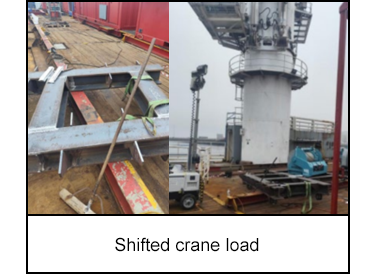-
What happened?
A vessel crane was lowering winch grillage into position on the vessels deck for disconnection.
As the crew prepared to disconnect the load, the crane unexpectedly began lifting again.
The load shifted during the lift and struck one of the rigger’s legs.
The incident happened close to the crane pedestal where the operator had limited visibility.
All members of the crew were wearing the correct Personal protective equipment (PPE) for the operation.

-
Why did it happen?
The equipment on board was not fully functional, particularly the radio transmission.
The Crane command was misheard and there was no communication verification, so efficient action was delayed.
Permit to work was not put in place.
The rigger was allowed to approach load whilst commands were still being issued.

-
What did they learn?
Ensure strict testing and assurance of communication methods during crane operations.
Technicians need to ensure crane communication procedure include effective verification commands.
Crane operations should cease until technicians are outside of the line of fire.

-
Ask yourself or your crew
Is the team performing the operation wearing the correct PPE? What is this?
How can this risk be minimised during large scale operations in the future?
Is everyone aware of the correct communication protocols for operations?
Are there enough spotters/technicians/operators on board to effectively mitigate risk?

Add to homescreen
Content name
Select existing category:
Content name
New collection
Edit collection
What happened?
A vessel crane was lowering winch grillage into position on the vessels deck for disconnection.
As the crew prepared to disconnect the load, the crane unexpectedly began lifting again.
The load shifted during the lift and struck one of the rigger’s legs.
The incident happened close to the crane pedestal where the operator had limited visibility.
All members of the crew were wearing the correct Personal protective equipment (PPE) for the operation.

Why did it happen?
The equipment on board was not fully functional, particularly the radio transmission.
The Crane command was misheard and there was no communication verification, so efficient action was delayed.
Permit to work was not put in place.
The rigger was allowed to approach load whilst commands were still being issued.
What did they learn?
Ensure strict testing and assurance of communication methods during crane operations.
Technicians need to ensure crane communication procedure include effective verification commands.
Crane operations should cease until technicians are outside of the line of fire.
Ask yourself or your crew
Is the team performing the operation wearing the correct PPE? What is this?
How can this risk be minimised during large scale operations in the future?
Is everyone aware of the correct communication protocols for operations?
Are there enough spotters/technicians/operators on board to effectively mitigate risk?
A crane lifted unexpectedly during load disconnection, causing a shift that struck a rigger’s leg. All crew wore proper PPE.













